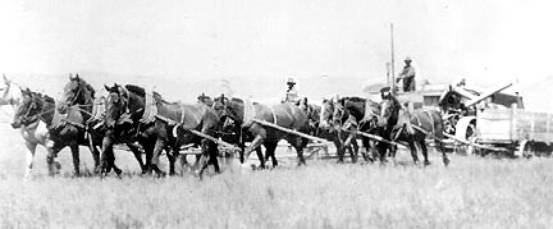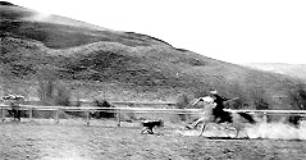
Vernell, page 3
A TYPICAL
WINTER DAY IN MY TEENS
We had to chop
the Juniper Cedar with an ax. It
was some of the best stove wood any one could ask for.
To this day, I have never felt a better heat.
We didn’t have much paper in those days to start a fire, but we
could ruff up the cedar bark and twist it and in that way it was as good
as paper. It would take
right off and we would soon have a roaring fire.
When I was
about fourteen I would listen for the clock to strike 7AM and get up to
make the fire, but sometimes Mom would beat me to it.
Then she would start breakfast and I would go to the barn to feed
and harness the team, while she would get the kids ready to go to
school. I would hook my
team to the sleigh with the header box on it and drive down the field a
mile and load it with straw. Then
I would come back and throw it out on the snow, fork full after fork
full, so the team could walk slowly on, three miles to the school.
If we needed
wood I, or we, would change the team to the other bob sleigh and go to
the mountains one mile away, and get a load.
If it was Saturday, Harold and Edd would go with me.
I tried to always have enough wood on hand to do us through a
blizzard. When we got to
the mountains, we would unhook the horses from the sleigh, unhook only
the best straps, and let the tongue down, pull the iron pin that held
the doubletrees to the sleigh and put a clevis on, hook a long chain on
it, start the team up the drag trail.
We would hang on to the chain and we would be pulled right up the
mountain. We would stop the
team to let them rest when they needed it.
When we got to where the trees were that made the best wood, I
would hook the chain around the top of the trees and pull them over with
the team. If we couldn’t
pull all the tree out with the team, we would chop the tree partly
through or cut some of the roots, but there were not many that the team
didn’t pull over.
The horses got
very good at pulling down trees.
I would try it one way and if it didn’t come, I would swing
them so they would pull from a different angle and down the tree would
come.
Harold and Edd
would be cutting off branches and cutting down smaller trees.
They might find some cedar post and we could sell them for 25 to
40 cents a piece. If we got
a hundred of them we thought we were rich.
We would take
the four largest trees and lay them side by side.
Then, half hitch the chain around the big ends, hook the chain to
the doubletree and the horses would pull until the chain was tight.
Then we would pile all the smaller stuff on top of the drag and
make a good wagon load. It
was easy for the horses to pull it down the steep drag trail to the
sleigh or wagon.
Sometimes Dad
would have money to purchase alfalfa hay, and
we would get it from the hay lands ten miles away.
When he went for a load, he would usually get a late start and
get home way after dark.
When I got big
enough to do the hauling, I decided that I would rather get home with my
load of hay before dark. So,
I would get up, start the fire and go out to feed and harness the horses
very early. It would be
black in the barn and I would have to go by feeling.
Mom would cook breakfast for me and I would go back to the house
to eat. Then I would pump
water for the team to drink, hook the team to the Bob sleigh with the
hay rack on, then would start them down the road.
It would be
daylight by then and I would start the team on a trot, tie the lines to
the front post, then I would step off the rack and run behind the
sleigh. Sometimes the
horses would keep on this slow trot for a mile or more and because it
was so cold, I just kept running behind the sleigh.
When I got to
the hay stack, sometimes I would have to shovel the snow off before I
could take the hay knife and start cutting down through the stack.
The hay knife was about a foot and a half long so I could pitch
that much hay at one time then to the next until I had a load.
The owner would measure the amount of tons and mark it with
stakes. I have forgotten
how many cubic feet it took to make a ton.
We usually bought ten tons.
The horses
would eat while I was loading the rack.
On the way
back, I had to cross the creek bottom which was a steep grade.
The team had to hold that load for about 500 feet.
It was dangerous because half way down, there was a canal with a
bridge across it . The
roads were packed snow and ice making hard for the horses that weren’t
shod. The creek bottom crossing was about a half mile south of Grandpa
Sparks ranch seen in the picture. On the other side of the creek bottoms they had
to pull the load up to valley level. It took special horses to do that
work.
I always got
home before dark.
Dad would get
the kids off to school in a smaller sleigh, then feed the chickens and
take care of the rest of the stock.
Harvest
was a big event. We headed
and stacked, then when the thrasher came, it was a big steam engine with
wheels as high as a man’s head. It
would pull the thrasher and furnish the power to separate the grain from
the straw. It took nine or
ten men to keep it going. Later,
the companies that built he header and thrasher put them together and
called it the combined harvester that was pulled with horses.
You can see it in the picture of me driving fourteen horses.

It would take
all day to get from home to Malad with a wagon load and four horses, but Dad had
one team that could make it easy in three hours with the buggy…I worked one
year helping with the harvest. About halfway through, Colen Sweeten asked me if
I would drive the horses. At first
I didn’t think I could, but he said, ‘Sure you can.’
Well, I got up there, with only two lines, and bridles only on the
leaders. Colen told me that all I
had to do is hold the lines, and one other thing,
‘when you get to the corners, you may have to hold the left line to
keep the leaders from coming around too fast.’
He was right. In a few days
I had so much confidence that I could have driven those horses with my eyes
shut…

Vernell on white horse
OLD DUTCH
One day Colen
Sweeten asked me if I would go down in the mountain range about eight to
ten miles and see if I could find some of his horses that had gotten
away. He hadn’t been able
to find them after a couple of years of searching.
It was rough country with steep hills and canyons, rock ledges,
steep banks and washes, and a lot of juniper cedar trees.
He told me to take Old Dutch.
When I got to about where I thought the horses were, I had been
riding about two hours. I
traveled the top of the mountain range and around the highest peaks.
Salt Lake was way off in the distance and I couldn’t tell which was lake and which was sky. It looked like the mountains in the distance were floating in
the sky. After riding that
far in such rough country, I thought Dutch would be too tired to bring
the horses home if I did find them.
At some point,
I could hear horses running. They
had heard me coming and were traveling away from where I was.
I started Dutch after them.
They were going south and I wanted them to go north.
All I could do was to follow along for a while.
I hadn’t seen any horses yet, but I could see their dust.
Dutch and I were slowly gaining on them.
They were following trails that led out of the mountains.
When I did see them, they were much closer than I thought. There was a spring nearby called Showel’s Spring.
The horses ran passed the spring and followed the trail down into
the valley where there were fences and roads.
At this point, they were running west and I had to turn them into
the first lane going north. I urged Dutch passed the bunch in time to make the turn.
I could see the RS brand on two of the horses and four of
Colen’s.
What a horse.
He had traveled quite a distance up hill, outrun a bunch of
horses and was still going.
You don’t find many horses as fast with as much staying power
as Old Dutch. He was a blue
roan. Although he wasn’t
my horse, I will never forget him.
In 1927 my Dad
bought a new Star car, which was a big event.
I never trusted the Model T car, so I did most of my courting in the
buggy, sleigh or on horseback. Mable
Jensen was my girl for a long time.
| Page 1 | Page 2 | Page 4 | Page 5 | Home |